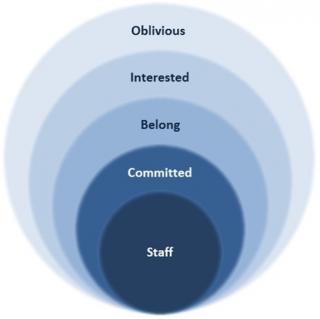You Talkin' to Me? Targeting Your Communications
As leaders of a congregation, it may be tempting to assume everyone else has (or should have) the same level of commitment to the institution of the church as we have. This can have unfortunate results in everything from volunteer recruitment to stewardship conversations--even to mission and vision work. Let me suggest a different way of framing . People in congregations have different levels of commitment and belonging, and it's important to host conversations and frame messages differently for each different level. Here is an overview of those levels:
- Staff refers to paid staff and lay leaders with “high commitment” who hold themselves accountable to the congregation’s mission. They have a good understanding of the congregation's history and culture ("DNA") and are willing to "stay at the table" through thick and thin as the congregation grows and changes.
- Committed leaders and volunteers care about the mission or the institution and help keep the church functioning by filling needed roles. They have a general understanding of the history and culture, but may have particular ministries that they feel they need to advocate for. Committed leaders can become burnt-out if they serve in roles that aren't a good fit for them.
- Those who Belong are members or pledging friends who attend worship and some programs and volunteer at various levels. Folks in this group may need some attention and direction around understanding the history, culture and mission of the congregation and in discerning how to serve using their own gifts and passions.
- Those who are Interested are occasional attendees to church programs who are still in discernment about whether or not the congregation is a good fit for them. They may not have much understanding about the history and culture and aren't really clear about mission.
- Those who are Oblivious are people who are in your community, or who may stumble across your website or attend a program held in your building, but don't really know (or care) much about your congregation.
Using this framing can help you craft different messages for the different groups during your stewardship campaign or when you create volunteer roles and recruit for them. This framing is also extremely useful when you are crafting and implementing mission and vision work.
There is often a suggestion that everyone who has any connection to the congregation be equally involved in the process. I suggest that--because the inner circles of leaders have such a deep connection to the history and culture and they come the closest to embodying the DNA of the congregation--it makes sense that they get general input from the congregation (using powerful questions (PDF)) then take the lead in crafting mission and vision draft statements before having the circles of "belonging" and "interested" folks try them out.

